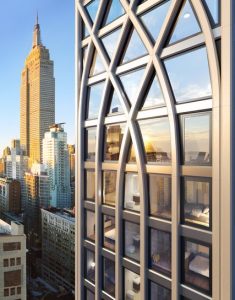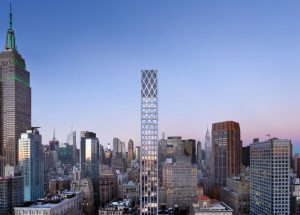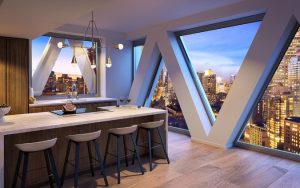A New Manhattan Tower With a Gothic Twist

A slender new condominium tower rising at 30 East 31st Street in Manhattan hopes to evoke both the golden glow of its neighborhood’s past as well as the area’s emerging reputation as a retail design destination.
“I didn’t want to build a glass tower that could be anywhere,” said Erik Ekstein, the president and chief executive of Ekstein Development Group, which is developing the building with the Pinnacle Group. “I like to do projects that are very contextual within the neighborhood.”
In hopes of creating something uniquely of its place, he turned to Morris Adjmi, a New York-based architect who frequently designs contemporary buildings that riff on details of neighboring structures.
Among Mr. Adjmi’s condo projects are the brick-townhouse-like building at 465 Pacific Street in Boerum Hill; the metallic doppelgänger of an existing 1905 warehouse for the Sterling Mason at 71 Laight Street; and a building with decorative terra cotta details at 207 West 79th Street.
This time, Mr. Adjmi said he was inspired by the pointed neo-Gothic details of neighbors such as the Kaye Building at 105 Madison Avenue and the Remsen Building at 148 Madison Avenue.
At 40 stories and about 470 feet, 30 East 31st Street, located between Madison and Park Avenues, will be the tallest building of Mr. Adjmi’s career so far, so he also looked to Manhattan’s most iconic skyscrapers.
“What can we do to create a classic New York skyscraper,” he asked himself, “something that really talks to the Chrysler Building, to the Empire State Building?

One of the key differences between those towers and newer buildings, he noted, is that they culminate in spectacular tops where many contemporary buildings tend to end uneventfully when they reach a required height.
Mr. Adjmi’s design “starts out with vertical pilasters,” he said, but these structural members curve near the top of the building and “terminate in this weaving that speaks to that Gothic architecture you see at the ground plane, but then is also recognizable in the skyline.”

Inside, there are 13 one-bedroom apartments on floors 2 through 8, starting at 866 square feet and $1.65 million. But from the 9th floor up, there is a single 1,677-square-foot two-bedroom apartment per floor, starting at $3.5 million. At the top, there is a 3,354-square-foot three-bedroom duplex penthouse for $12 million, where windows look out in all directions through the building’s zigzagging structure.
The apartment interiors include wide-plank white oak floors; bathrooms with Calacatta Prima and Bleu de Savoie marble; and kitchens with walnut cabinets, quartzite counters, and Wolf, Sub-Zero and Bosch appliances.
To market the building, which is not in a very residential area, the developers have partnered with the nearby New York Design Center, which houses about a hundred furniture showrooms at 200 Lexington Avenue, between 32nd and 33rd Streets.
“There’s an important synergy between luxury real estate and design neighborhoods that nobody is capitalizing on,” said James Druckman, the president and chief executive of the New York Design Center. “We can work together to enhance what’s going on at their building and show people the value of good design.”

Plans include dinner events and panel discussions with designers for prospective buyers and brokers in the center’s showrooms, joint window displays, and an eventual designer show house at 30 East 31st Street. The design center is also hosting the development’s launch event on November 1.
These activities build on the growing number of design-focused stores within a few blocks of the development, including B&B Italia, Natuzzi, Poliform, Luxury Living, DDC, Suite NY, M2L, Duravit and Dover Street Market. Numerous furniture companies that once had stand-alone stores in NoHo and SoHo have also relocated to the New York Design Center, including Aero, Desiron, Dune and Lobel Modern.
“It’s the re-emergence of a design district,” said Bruce Ehrmann, an associate broker at Douglas Elliman Real Estate, which is leading sales and marketing for the building. “It was a design district 30 or 40 years ago that all but disappeared, and now it’s roaring again.”
Construction of the building is underway, and Mr. Ekstein said he expects it to be completed in the spring of 2019.
Source: NY Times

 USA 917-679-1211
USA 917-679-1211






 © Jackson Lieblein, LLC 2015.
© Jackson Lieblein, LLC 2015.
